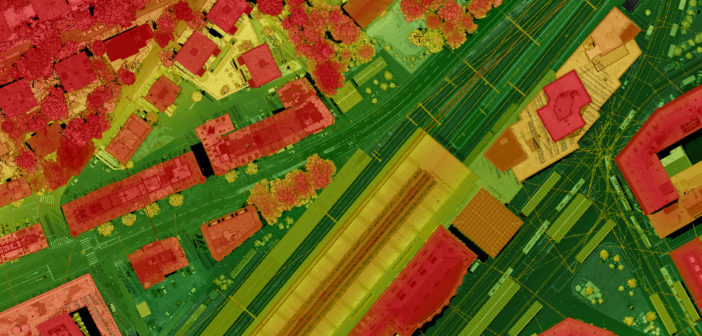I recently sat on a panel with industry colleagues titled The Future of LiDAR and sponsored by Geo Week. The panel shared insights and future predictions of airborne sensors, UAVs, Content as a Service (CaaS), and many more technology topics affecting our industry. The shared discussion brought about ideas and trends we’re seeing and the factors leading change in the geospatial sector.
As the first presenter on the panel, I had the opportunity to speak about what is driving this change in LiDAR. Today, we are seeing LiDAR in so many more applications than ever before – from accident reconstruction diagrams to autonomous vehicle navigation to even in your Apple iPhone for the next frontier in Augmented Reality (AR). Considering that 20 years ago if I was explaining to someone on the street what industry I work in, it would have taken 30-minutes to today just saying “I work with LiDAR” as the easier explanation, this technology has come a long way.
What are the trends?
Focusing on the more traditional aspect of LiDAR, though, in aerial mapping, we see specific customer trends driving innovation. In what I call the Hybrid Sensor Paradigm, there are four main factors in the market moving our industry forward:
- Faster Refresh Cycles
Customers are asking for more current data. As their work depends on the most accurate information, they need to base decisions on more relevant and up-to-date data. - Larger Area Coverage
For a more complete picture, customers want coverage of larger areas. No longer viable are the piecemeal portions of areas flown at varying point densities and accuracies that were previously put together to form a makeshift mosaic. Now, complete datasets of full regions with consistent density, geometry and accuracy are required. - Higher Resolution/More Insights
More information from each flight is desired, so higher spatial resolutions are needed. Customers require clear and crisp details for better informed decision making, not only XYZ points, but reflectance or intensity data and color (natural or false-color IR). - More Cost Effective
Of course, lower and lower costs are requested to ensure all other areas of the process can be covered. With more affordable and encompassing solutions, the democratisation of technology is enabling more and more customers to benefit.
These factors, in turn, then drive the focus of the Geospatial Content Solutions business of Hexagon’s Geosystems division into three main areas:
- Efficient Capture
More data is needed from each flight to bring about more efficient operations. With a hybrid airborne sensor, such as the Leica CityMapper-2, this is achievable. Combining imaging and LiDAR in one flight, twice the data can be captured in half the time at vastly improved data quality. - Efficient Processing
Highly automated workflows are a must for faster refresh cycles, reduced data latency, higher resolution and more cost-effective processes. Using multi-sensor post-processing software with automatic features, like Leica HxMap, saves time and money and enables users to focus on other aspects of the business. Data is also able to be driven quicker through the pipeline to the end user, and with higher quality. - Easy Accessibility
To get the data into the hands of the end users as quickly as possible with as small of a technical learning curve as possible, we turn to more Content as a Service (CaaS) opportunities. With the HxGN Content Program, current, large-area, high-resolution imagery is made available off-the-shelf at the most affordable costs, because one data acquisition can serve multiple end-users.
What are the challenges?
Since the mid-1990s we have seen the effective pulse rate of LiDAR double about every two-and-a-half years. To keep up with, indeed, to drive this trend, there are challenges. More data needs to be acquired quicker; scan rates have to increase to keep up with the pulse rates; and processing turnaround times have to decrease.
To overcome these challenges, we have various choices. We could develop more sensitive detection systems or place bigger lasers on these sensors. Each choice, though, comes with its own sets of concerns.
If we use more powerful lasers, we run into eye safety concerns. This may also solve the age-old leaf-on/leaf-off conundrum as, with enough laser power, you may end up just burning the vegetation all together! Higher sensitivity systems, on the other hand, come at the price of higher noise levels. Detector technology is also limited in more “eye-safe” alternate wavelengths. So where does that leave us?
What does the future hold?
We’re starting to see a segmentation in the LiDAR market. High-pulse rates and eye safety can be attained with linear-mode LiDAR, single-photon (SPL) and Geiger-mode (GML) LiDAR. There are, however, trade-offs. With SPL and GML, there is higher noise and lower fidelity, while linear-mode still delivers the highest-quality in general.
This results in two use-case segments:
- Low-energy/High-Pulse Rate
Linear-mode systems are dominating at lower flight heights and smaller coverage areas. Projects like smart city planning or corridor mapping are ideal for linear-mode systems using low-energy/high-pulse rate technology. - High-sensitivity
SPL and GML are more productive in handling larger coverage areas at higher flight heights that would not be affordable for linear-mode systems to perform. Complete state and country mapping projects are best suited in this category.
As we go into the future, there are several opportunities for LiDAR to grow in use through many applications. This is a technology that will continue to evolve to meet the needs of professionals around the world. In the end, we can already see the convergence between various LiDAR technologies as well as the synergies between LiDAR and imaging technologies that will result in “better data, faster”.
With a 41-year career in the electro-optics industry, Ron Roth serves as the product manager for Airborne Topographic LiDAR at Leica Geosystems. In this role, he provides both technical and marketing inputs for product development and design on Leica Geosystems’ airborne topographic LiDAR systems.















